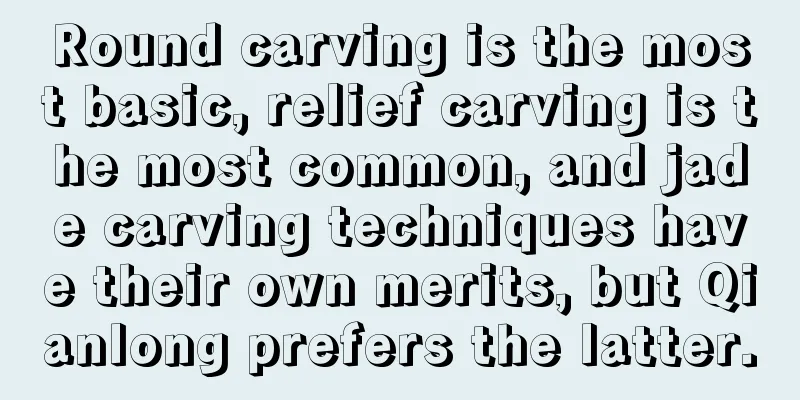Round carving is the most basic, relief carving is the most common, and jade carving techniques have their own merits, but Qianlong prefers the latter.

|
A gentleman compares his virtues to jade. People believe that the qualities of jade correspond to human virtues, namely benevolence, righteousness, wisdom, courage and purity. If jade is not carved, it cannot become a useful object. Jade raw materials only have a warm texture, but carved jade has many beautiful meanings. People pay more attention to jade themes, so the development of jade carving is getting faster and faster, and jade carving techniques are also diverse. Today, the main jade carving techniques used by jade carvers include round carving, relief carving, hollow carving and clever carving. Round SculptureRound carving, also known as three-dimensional carving, is the most basic carving technique in jade carving. Round carving is done from all directions of jade, so special attention is paid to the unity, harmony and integration of all angles and directions. ReliefRelief is not only used in jade carvings, but also in sculptures made of other materials, such as wood, metal, etc. There are many materials suitable for relief, so relief works are widely found in various occasions such as temples, tombstones, caves, etc. Relief can be three-dimensional or two-dimensional; it can exist independently or be attached to other carriers. It is a very magical carving technique. Relief can be divided into high relief, medium relief and shallow relief. Bas-relief has a stronger sense of flatness and is closer to painting. Medium relief has more layer changes; high relief has a stronger sense of three-dimensionality and emphasizes the overall composition of the foreground, middle ground and background. CarvingHollow carving is also called openwork carving, which means hollow carving through jade material. Hollow carving can make the jade appear to have two sides connected. Hollow carving is very difficult. Jade carvers and designers must have a good control over the overall jade to make every surface appear in its best condition. In addition to the three more common carving techniques mentioned above, there are also some relatively niche carving techniques in the jade industry. Colorful carvingColor-matching carving is a technique that uses the natural color of jade to carve. It is generally used on jade with mixed colors. The design is based on the colorful parts of the jade, with the main color as the base. The original mixed colors become the finishing touch through design, and the overall color of the jade carving will not be too chaotic. Chain carvingThe jade carvings created by chain carving are also called chain jade wares. Chain carving emphasizes “taking the material but not separating it from the body”, which is also the most difficult. Only jade that is fine, hard and large enough can ensure the integrity of the chain, so the selection of materials for chain carving is very difficult. It is even more difficult in actual operation, as every link requires precision. If there is a mistake in any place, all the previous efforts will be wasted. Pressed wire inlayPressing wire and inlaying gems sounds very sophisticated, but it is actually not complicated. Pressing gold and silver wires on jade and inlaying gems on jade is called pressing wire and inlaying gems. Wire pressing requires carving grooves on the jade article, and then using a small hammer to knock the gold and silver wires into the grooves to form a pattern, so that the gold and silver wires and the jade article appear on the same plane. Pressed wire and inlaid gems are very common today and no one is surprised by them, but in ancient times when the level of science and technology was backward, this was very rare. Thin tireThe thin-body technique is the most advanced skill in the jade carving industry. It originated in ancient Persia and was later introduced to China. Thin-bodied jadeware was called "Hindustan-style jadeware" in the early days, or Hen jade for short. The thin-body technique can lighten the color of jade and make it whiter. It is generally used for jasper and green jade. Jade carvings created with the thin-body technique appear lighter and can highlight the transparency of the jade. Legend has it that Emperor Qianlong was very fond of this kind of jade carving, but the craftsmanship was rather complicated and the production cost was probably beyond the reach of ordinary people, so it was later lost. It is precisely because of so many different carving techniques that the carved jadeite in the jade market is so rich and colorful. Different carving techniques have different charms. Which carving technique do you prefer for jade carvings?
fruit fcgc33 |
>>: Eight things not to do when buying jadeite: the experience of our predecessors!
Recommend
High-quality jade has "four good qualities" and one good quality is not enough
The editor has shared with you a lot of knowledge...
Jade Appreciation | Catch the tail of summer and enjoy the last coolness!
Throughout the year, some people like spring, som...
Can you tell the difference between old jade, old type jade and old pit jade?
The more you understand jade, the more you realiz...
A tree, a house, and a dog, a pleasant pastoral theme, saving the garbage black-bone jadeite
When talking about black chicken jadeite, the fir...
Jade investment value
Jade is a treasure bestowed by nature on mankind....
There are only three indicators to distinguish jade carvings: "clever", "pretty" and "exquisite"
The “Skill” of Jade "Skillfulness" refe...
Correctly judging the "color" of jade is the only way to become an expert
Jade comes in a variety of colors, including red,...
When playing with jade, do you know the places that jade is "afraid of"?
Jade is known as the "King of Jade" for...
Take you on a tour of jade culture and experience
Today I will talk to you about jadeite. Speaking ...
The ultimate beauty of jadeite!
Since ancient times, jade has been regarded as th...
The meaning of jade zodiac
The zodiac culture is very Chinese and has penetr...
The carving master cut the jade sheet into two pieces to carve. The finished product is really amazing.
A jade friend mailed me a palm-sized piece of jad...
These eight tips will help you buy good jadeite that is worth the money
Jade is one of the most popular jewelry categorie...
Jade peace buckle, the double meaning you don’t know
Mid-Autumn Festival is approaching As the moon be...
Why does jadeite with good water quality always seem to have no color?
When evaluating the quality of a jadeite, we usua...









